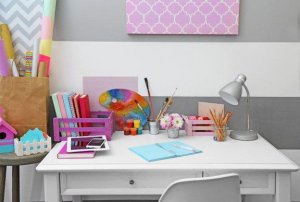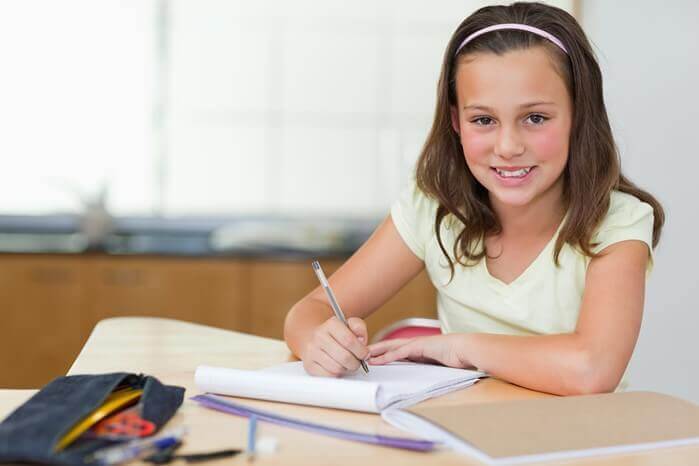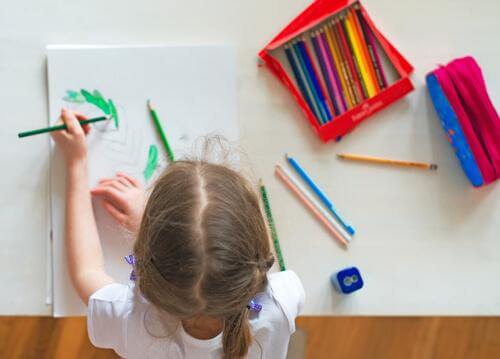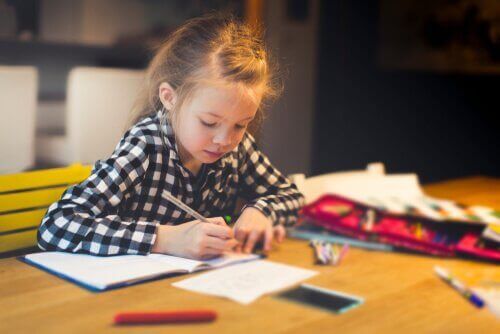10 Great Ways to Prepare a Study Desk for Your Child

Once children reach pre-school age, most parents face a new challenge: encouraging their children’s study habits. Yes, studying is a habit. Providing a good study desk for your child is a great way to encourage him or her to do schoolwork and learn at home.
When it comes to good study desks, it’s very important to plan and organize things that children like, always taking into account their age and needs. Also, don’t forget that motivating children through play is a fundamental and important aspect.
Discover: Tricks for Motivating Children to Study

Prepare and organize a comfortable, pleasant physical space that has all the necessary furniture. You’ll need a desk, chair, shelf, and items that let kids do their homework without any distractions.
This promotes their study habits and guarantees intellectual development. Of course, don’t forget that this space should be organized in a way that’s attractive and interesting for your child.
Preparing a study desk for your child
First you need to choose where you’ll place the desk. Most likely it will be in your child’s room. You may use a small table or desk with a chair next to his bed.
Whether this space is in his room or another part of the house, it’s important for your child to have easy access to the resources to carry out school activities without distractions.
This space should have good lighting and several other components that we’ll show you below. The idea is to learn to organize your space comfortably and, of course, in an appealing way.
Want to see more?: 3 Ideas to Decorate Your Children’s Study Room

General features of a study desk for your child
Height
The desk should have a height that’s suitable for your child. We recommend that it be chest height so that your child can comfortably rest his arms. In addition, the surface of the desk should be smooth and a soft color that the child likes.
Location
The desk should be placed so that your child’s view is pleasant, but also helps him concentrate. The central part of the desk should always be clear so that he can spread out books and notebooks.
Measurements
It doesn’t need to be very wide. However, the measurements vary depending on the space and your child’s age.
Lighting
It must have good lighting. If it’s convenient or necessary, you can place a table lamp next to your child. However, if your child is left-handed, the lamp should be on the right side, and vice versa.

Materials
1. Chair
The chair should be appropriate for your child’s height so he can rest his feet on the ground. In addition, it should be at a 90-degree angle with respect to his hips.
2. Support
On the desk, you can have a stand to prop books on. That way, when your child is reading, he can maintain good posture.
3. Computer
If there’s a computer or laptop, it should be in a fixed spot. That way, your child can only use it when he needs it for homework, not to play video games or surf the internet.
4. Organizers
Use organizers and pencil holders on and around the desk. You can even let your child help pick where he wants to have organizers.
5. Games
You can even place puzzles or other learning games on the desk. In addition to looking nice, it’ll help stimulate the learning process.
Once children reach pre-school age, most parents face a new challenge: encouraging their children’s study habits. Yes, studying is a habit. Providing a good study desk for your child is a great way to encourage him or her to do schoolwork and learn at home.
When it comes to good study desks, it’s very important to plan and organize things that children like, always taking into account their age and needs. Also, don’t forget that motivating children through play is a fundamental and important aspect.
Discover: Tricks for Motivating Children to Study

Prepare and organize a comfortable, pleasant physical space that has all the necessary furniture. You’ll need a desk, chair, shelf, and items that let kids do their homework without any distractions.
This promotes their study habits and guarantees intellectual development. Of course, don’t forget that this space should be organized in a way that’s attractive and interesting for your child.
Preparing a study desk for your child
First you need to choose where you’ll place the desk. Most likely it will be in your child’s room. You may use a small table or desk with a chair next to his bed.
Whether this space is in his room or another part of the house, it’s important for your child to have easy access to the resources to carry out school activities without distractions.
This space should have good lighting and several other components that we’ll show you below. The idea is to learn to organize your space comfortably and, of course, in an appealing way.
Want to see more?: 3 Ideas to Decorate Your Children’s Study Room

General features of a study desk for your child
Height
The desk should have a height that’s suitable for your child. We recommend that it be chest height so that your child can comfortably rest his arms. In addition, the surface of the desk should be smooth and a soft color that the child likes.
Location
The desk should be placed so that your child’s view is pleasant, but also helps him concentrate. The central part of the desk should always be clear so that he can spread out books and notebooks.
Measurements
It doesn’t need to be very wide. However, the measurements vary depending on the space and your child’s age.
Lighting
It must have good lighting. If it’s convenient or necessary, you can place a table lamp next to your child. However, if your child is left-handed, the lamp should be on the right side, and vice versa.

Materials
1. Chair
The chair should be appropriate for your child’s height so he can rest his feet on the ground. In addition, it should be at a 90-degree angle with respect to his hips.
2. Support
On the desk, you can have a stand to prop books on. That way, when your child is reading, he can maintain good posture.
3. Computer
If there’s a computer or laptop, it should be in a fixed spot. That way, your child can only use it when he needs it for homework, not to play video games or surf the internet.
4. Organizers
Use organizers and pencil holders on and around the desk. You can even let your child help pick where he wants to have organizers.
5. Games
You can even place puzzles or other learning games on the desk. In addition to looking nice, it’ll help stimulate the learning process.
All cited sources were thoroughly reviewed by our team to ensure their quality, reliability, currency, and validity. The bibliography of this article was considered reliable and of academic or scientific accuracy.
- Cortese, A. (2011). Técnicas de estudio. Metodología de la investigación.
- Narváez, M. R. T., Guzmán, I. T., González, M. D. C. U., & Robayo, A. M. M. (2009). Hábitos de estudio vs. fracaso académico. Revista educación, 33(2), 15-24. https://www.redalyc.org/pdf/440/44012058002.pdf
- Ramos, C. B. (2007). La incidencia de las TICs en el fortalecimiento de hábitos y competencias para el estudio. Edutec. Revista Electrónica de Tecnología Educativa, (23), a077-a077. http://edutec.es/revista/index.php/edutec-e/article/view/497
- Art Markman Ph.D. (2012). Developing Good Study Habits Really Works. Sychonomic Bulletin & Review.
- Robert Bjork y Nate Kornell. (2007). Principles of cognitive science in education: The effects of generation, errors, and feedback. Psychonomic Bulletin and Review.
- Quintanilla Paz Soldán, F. ( última consulta octubre 2019). Hábitos de estudio. [ material de apyo al tutor]. Recuperado de: www.prepa8.unam.mx
- VIU. (17 noviembre 2015). Lad técnicas de estudio mejor valoradas pata niños. Recupetado de: www.universidadviu.es
- Gabinete Psicodiagnosis (s.f.). Como motivar a estudiar. Recuperado de: https://psicodiagnosis.es/areageneral/otros-temas/como-motivar-los-nios-a-estudiar/index.php
This text is provided for informational purposes only and does not replace consultation with a professional. If in doubt, consult your specialist.








